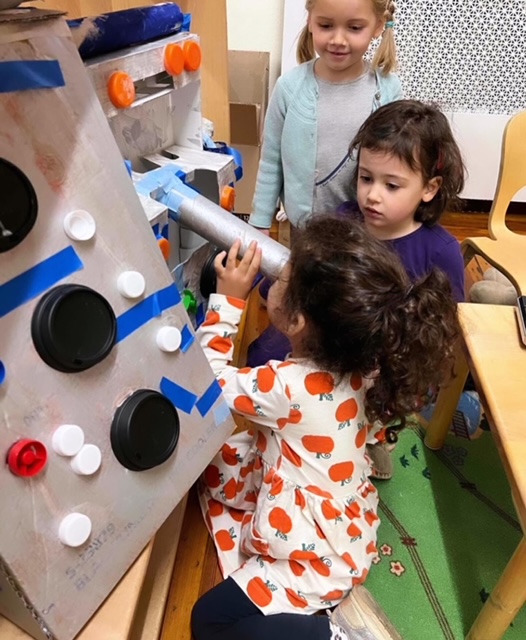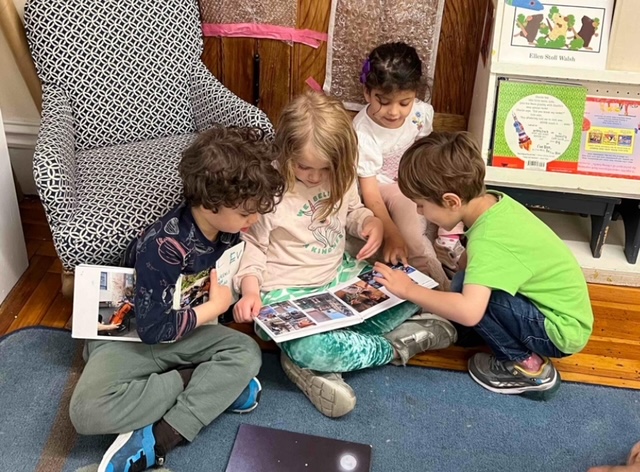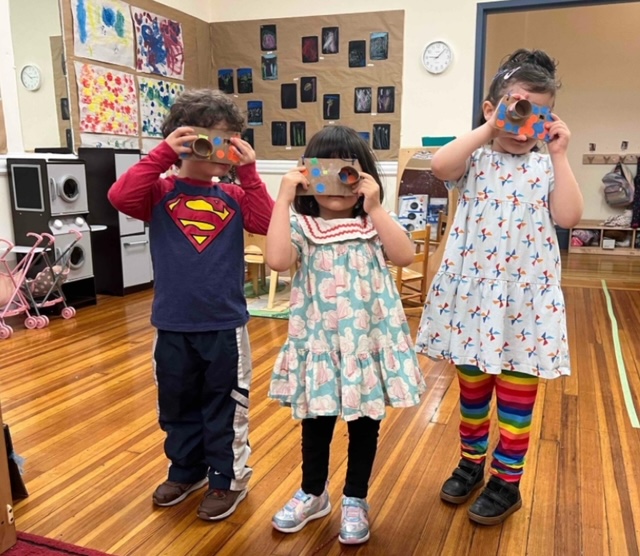During a child’s day at GLS, they engage in a variety of experiential activities that are purposefully chosen with a developmentally appropriate philosophy in mind. Below are some examples of ways early learning takes place throughout a school day.
Using a child-created “Mission Control Center” that a yearlong project theme.
Projects:
Teachers develop curricular projects based on children’s interests and authentic questions. Following the model laid out in Helm & Katz (2011): Young Investigators, teachers observe, document, discuss, create webs and develop the phases of a project, co-constructing knowledge with the children using field visits, experts, artifacts, documentation, culmination and evaluation. Teachers integrate literacy, numeracy, art, music, and science into projects.
Looking at each other’s family books in the Calming Corner, where children are provided with sensory materials, feelings charts, and books that help them to feel grounded throughout the day.
Social-Emotional Development:
Social-emotional learning is a central aspect to the curriculum in the early childhood setting, and cannot be divorced from cognitive learning. Children are learning about themselves, each other, their families, their similarities and differences. Through the support and guidance of teachers, they learn to identify their feelings and to talk about problems and how to solve them. Teachers support children’s healthy identity development in discussions of race, gender, family constellations, fairness and feelings. These discussions are integrated into the daily life of the classroom and help create a community that is responsible to each other.
Using recycles materials to build individual, 3-D collages.
Art:
GLS teachers provide children with process-oriented, constructivist art experiences. We look at the developmental stages of art expression as identified by Smith (1993), and give children appropriate materials and time to explore. Teachers use reflective language rather than praise when talking about children’s art work. (See addendum). Process-oriented experiences center on use of materials, teaching particular skills to manipulate materials, and allowing children freedom of exploration and expression as they progress through the developmental stages. They do not center on representation, “make and take,” or holiday-themed art projects. Resources: Lord, L. (1996) Collage and construction in school, Pile, N. (1990) Art experiences for young children; and Smith, N. (1993) Experience and art: teaching young children to paint. Copies of these books and others are available to borrow in the Director’s office.
An art specialist comes once a week to provide children with a guided art experience. The children deepen their visual / graphic vocabulary, motor and creative skills, and explore the use of tools. They experience collaborative and singular art projects.
Participating in a music class activity led by Gabriele, our Music Specialist.
Music:
Music is heard throughout our school. Children sing each day, as well, with several of the songs in their repertoire written by the teachers and children to support their curriculum. The children also have a formal music class once a week. They learn basic music terms and concepts, play rhythm and tonal instruments, dance, sing, and learn a repertoire of folk songs.
Using cardboard, paint, and collage materials to construct letters.
Literacy:
Pre-Literacy skills are taught in the context of current projects and interests of the children in the classroom. Developmentally appropriate and relatable books are rotated throughout the year. Children are read to daily and get chances during play choice times to look at books at their leisure. Depending on the age group, teachers are aware of certain pre-literacy skills that should be incorporated such as understanding the parts of a book, simple letter recognition through games, books, dramatic play, and art projects, and pre-writing skills developed through drawing, fine motor development, drawing shapes, and eventually forming letters (see creative curriculum’s developmental checklist by age).
Telling a story about bears that includes sorting and counting.
Math:
Children are introduced to pre-math skills in a developmentally appropriate, play based way. Math skills are also tied to interests and projects. This can look like practicing 1 to 1 counting with manipulatives during a game or activity, cooking and science projects, creating patterns through games and Art, measuring in dramatic play, block building, and other hands-on activities (see creative curriculum’s developmental checklist by age).
Children mix substances and colors to see the outcome.
Science:
Science in the classroom reflects current projects and interests. A science area in each classroom has rotating objects for children to explore, such as natural materials, magnifying glasses, books on science topics, measuring materials, and anything else they may have specifically inquired about. Children are encouraged to explore the natural world around them when they go outside and bring those interests into the science area. Cooking projects, making playdough, and other sensory experiments are facilitated by teachers throughout the school year.
Children make their own props for the dramatic play area which reflect a current theme in their lives
Social Studies:
Social Studies in preschool ties into the children’s experiences through their families, cultures, backgrounds, and neighborhoods. Children’s inquiries and discussions about their own families and the cultures surrounding them are supported in the classroom and can be a part of the curriculum. Talking about neighborhoods and family experiences helps children to understand themselves and their immediate environment. Dramatic Play is a big part of children understanding themselves and others. Materials in the classroom reflect the diversity of NYC: baby dolls with different skin tones, crayons, markers, paint and other art materials in various skin shades, dramatic play items that reflect different abilities, and books that include diverse characters. Families are encouraged to come into the classroom to share parts of their cultures, from food and dance to traditions and holidays.
Enjoying a turn taking game with our large parachute!
Gross Motor:
Young children need a lot chances for physical activity in order to feel regulated and to process information. We provide both outside time for the children and have indoor spaces where the children participate in things such as climbing, biking, and gross motor games. Older children begin the school year walking either to Riverside Park or Columbia Campus and spend an hour in the morning outside (children who stay for a full day get more outside opportunities later in the day). They also take walking trips to places like the grocery store or other local businesses if it is fitting for their current curriculum. Two year olds build up to walking outside in a group during the fall and eventually join the older children in the park or on campus. Children have the change to use the Climber Room and Parish Hall gross motor spaces throughout the day and school year.








